Orchid Aerides
Last reviewed: 29.06.2025
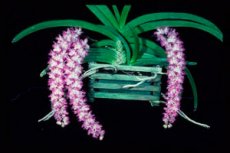
Orchid Aerides is one of the most unusual genera of orchids, native to the tropical regions of asia, known for its spectacular clusters of flowers with a pleasant fragrance. Aerides is a genus of epiphytic orchids that prefer to grow on trees, absorbing moisture and nutrients from the environment. In this article, we will take an in-depth look at the different types of Aerides, their cultivation features, and provide helpful care tips.
Etymology of the name
The name "Aerides" originates from the greek word aer (“air”), reflecting their epiphytic nature. These plants, which grow on trees, appear to “hang in the air.” This term was introduced by botanists to describe the airy nature of these orchids.
Life form
Aerides are typical epiphytes that inhabit the branches and trunks of trees in tropical forests. They use trees solely for support without parasitizing them. Their roots wrap around the tree's bark, anchoring the plant and absorbing moisture from the surrounding air.
In some cases, particularly in regions with high humidity, Aerides can exist as lithophytes, growing on rocks or cliffs. They are adapted to life with limited access to organic substances, deriving essential resources from rainfall and the air.
Family
Aerides belong to the orchidaceae family, one of the largest families of flowering plants. The family is distinguished by an enormous diversity of forms, flower structures, and pollination strategies.
Orchids have a unique morphology, including complex mechanisms for attracting pollinators. In Aerides, these features are expressed in their long inflorescences rich in nectar, which attract insects such as bees and butterflies.
Botanical characteristics
Aerides exhibit a monopodial growth pattern, meaning they grow vertically from a single growth point. Their roots are thick and covered with velamen, which helps efficiently absorb moisture and nutrients. The leaves are linear, fleshy, and arranged alternately along the stem.
The flowers are grouped in long, pendulous clusters that can reach up to 30 cm in length. Their coloration ranges from white and pink to purple, with various shades and patterns. The flowers are strongly fragrant, exuding a pleasant aroma.
Chemical composition
Aerides contain a variety of biologically active compounds, including essential oils, alkaloids, and flavonoids. These components are responsible for their fragrance and may possess antioxidant and antimicrobial properties. However, the chemical composition of this genus remains underexplored and requires further study.
Origin
Aerides originate from tropical and subtropical regions of south and southeast asia, including india, china, thailand, the philippines, and indonesia. These plants are common in lowland and montane forests, where air humidity remains high throughout the year.
Aerides are often found at elevations ranging from 500 to 1500 meters above sea level, growing on trees or rocks. Such conditions provide them with diffused light and stable humidity.
Ease of cultivation
Aerides require specific growing conditions, making them suitable for experienced gardeners. They need bright, diffused light, high air humidity, and regular watering.
For successful cultivation, it is essential to ensure good ventilation and avoid water stagnation around the roots. Hanging baskets or mounts are recommended to mimic their natural environment.
Types of Aerides orchids
Aerides includes many species, each with its own unique beauty. Below are the most popular types of Aerides orchids.
- Aerides crispum (Aerides crispum)
Aerides crispum is a species known for its dense clusters of white and pink flowers with a sweet fragrance. This orchid prefers bright light and high humidity, making it ideal for greenhouse cultivation. The flowers appear in the spring and summer months and can stay on the plant for several weeks, adorning the garden or home.
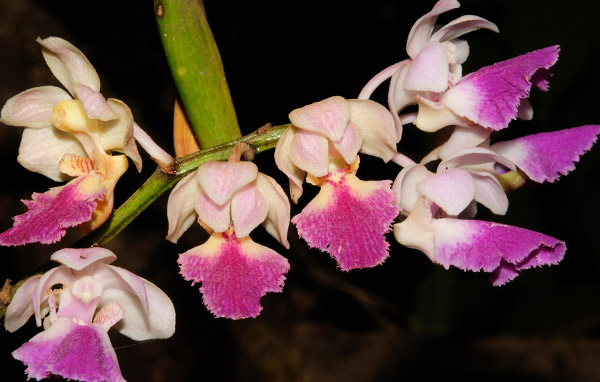
- Aerides falcatum (Aerides falcatum)
Aerides falcatum is another beautiful species distinguished by its long, arching inflorescences with white and pink flowers. This species loves light and needs good air circulation to prevent diseases. Aerides falcatum is a perfect choice for those who want to add an orchid with unusual, arching flower clusters to their collection.
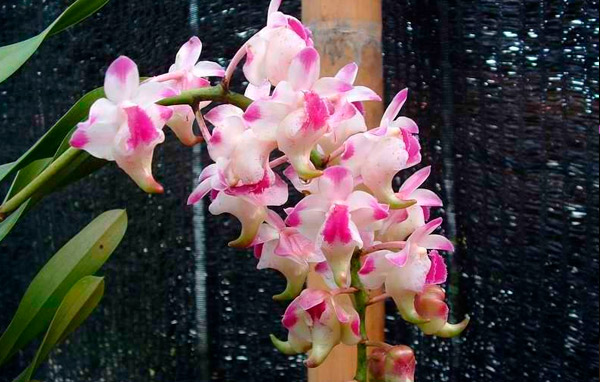
- Aerides odoratum (Aerides odoratum)
Aerides odoratum is known for its amazing fragrance, which is especially intense in the evening hours. The flowers are white with pink specks and are arranged on long flower spikes. This species requires high humidity and regular watering, as well as a bright but indirect light location.
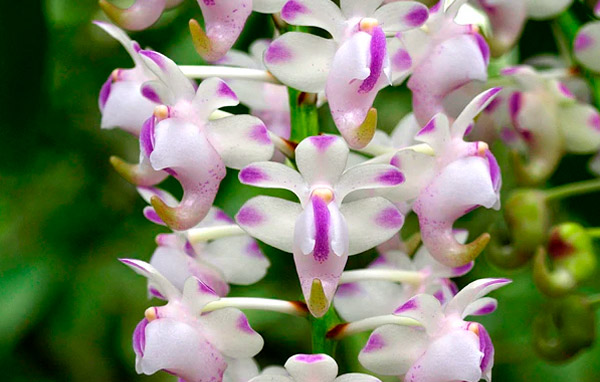
- Aerides houlletiana (Aerides houlletiana)
Aerides houlletiana stands out among other species with its bright yellow flowers with pink tips, making it particularly attractive. Like other Aerides species, this one requires high humidity and good lighting. Flowering occurs in the spring-summer period, and the flowers have a pleasant fruity aroma.
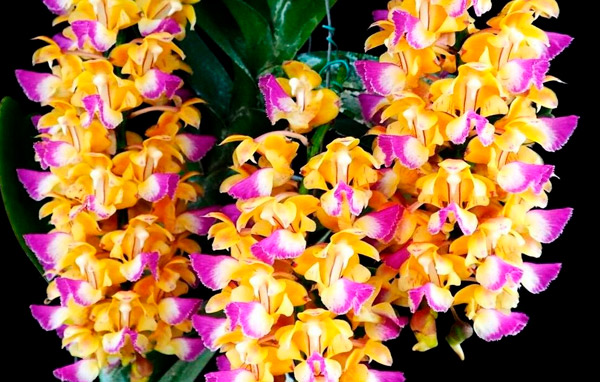
Size
The size of Aerides varies depending on the species. In their natural habitat, the plants can reach up to 1 meter in height, including the length of the stem and inflorescences.
In indoor cultivation, their size is often smaller, making them convenient for limited spaces. However, even in such conditions, Aerides produce large and striking floral clusters.
Growth rate
Aerides grow at a moderate pace. In stable humidity and good lighting conditions, they can produce several new leaves and roots annually, steadily increasing in height.
During the dormant period, growth slows as the plant focuses on storing resources for blooming. To encourage growth, it is important to maintain a regular feeding schedule and provide optimal lighting conditions.
Lifespan
Aerides have a long lifespan. With proper care, they can live for decades, delighting their owners with flowers for many years.
Longevity depends on regular care, repotting when necessary, and protection from pests and diseases. A proper approach to cultivation ensures the plant remains in good condition throughout its life.
Care for Aerides orchids
Aerides orchids require specific care that will help them thrive and delight their owners with abundant flowering. Here are the main recommendations for caring for this genus of orchids:
- Lighting
Aerides prefers bright but diffused light. Direct sunlight can cause burns on the leaves, so it is best to place the orchid in a spot with sufficient light but avoid direct sun. To ensure optimal lighting, you can use eastern or western windows or use a mesh to filter sunlight.
- Temperature and humidity
Aerides orchids like a warm climate with temperatures ranging from 20 to 30°c (68 to 86°f). These orchids require high humidity, ideally between 60% and 80%. To maintain humidity, you can use a humidifier or place the plant on a tray with water. It is also important to provide good air circulation to avoid stagnant moisture, which can lead to root rot.
- Watering
Watering Aerides orchids should be regular, especially during the active growth period. It is important to water the plant thoroughly, allowing the water to drain completely to prevent root rot. In the winter months, the frequency of watering can be reduced as the plant enters a resting state.
- Fertilizing
Fertilize Aerides every two weeks during the active growth period using a balanced orchid fertilizer. It is important to reduce the amount of fertilizer in the winter months when growth slows down to avoid overfeeding the plant.
- Repotting
Repotting Aerides orchids is done every two to three years or as the roots grow. It is best to repot the plant in spring using a mix of bark and sphagnum moss to provide good root aeration. When repotting, it is important to avoid damaging the roots, as this can lead to stress and slow growth.
Propagation of Aerides orchids
Propagation of Aerides orchids is often carried out by separating side shoots that appear at the base of the mature plant. These shoots can be carefully separated and repotted into individual pots once they have developed their own roots. Propagation can be done in the spring when the plant begins to grow actively.
Conclusion
Orchid Aerides is a magnificent plant that can become a real gem in any orchid collection. With its spectacular, fragrant inflorescences and variety of species such as Aerides crispum, Aerides falcatum, Aerides odoratum, and Aerides houlletiana, these orchids impress with their beauty and elegance. Caring for Aerides orchids requires attention to lighting, humidity, and proper watering, but with the right care, they will reward you with abundant flowering and a refined fragrance.
Growing Aerides orchids can be an exciting and rewarding experience for both beginners and experienced growers. By following the care tips, you can create conditions in which your orchids will thrive and delight you with their beauty for many years.
